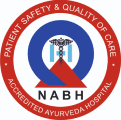



At AyurVAID, we offer safe professional care for stroke rehabilitation, aiming at your complete recovery and overall improvement.
AyurVAID Hospitals is now a part of Apollo Hospitals Group.
AyurVAID is a pristine institution that bears the virtue of Ayurveda. Our doctors, skilled and proficient in their field, are here to help you, by providing you with comfort and reassurance. At AyurVAID, we offer safe professional care for stroke rehabilitation, aiming at your complete recovery and overall improvement. In-depth assessment of the condition, precise diagnosis, thorough samprapti vighatana (breaking the disease pathway), properly planned prakriti-oriented treatment, quality procedures, safe and hygienic environment, etc are our peculiarities. We offer you complete care and cure for the conditions that ail you.
AyurVAID is India’s 1st Ayurveda hospital to be accredited by NABH (National Accreditation Board for Hospitals & Healthcare Providers), Quality Council of India.
Pakshaghata (hemiplegia) and Ardita are two Ayurvedic conditions that could be correlated to stroke. Vitiated vata could be cited as the culprit for both. Pakshaghata is the paralysis of one side of the body due to the constriction of blood vessels and ligaments as they host an aggravated vata. If the full body is paralyzed, the state is called sarvanga roga. Ardita, on the other hand, is the facial paralysis caused by the colonization of vitiated vata on the face. It vaporizes the blood there and causes contractions in the face. Both conditions are detailed in the 28th chapter of Charaka Samhita Chikitsa sthana.
Pakshaghata and ardita can be correlated to stroke. These occur as a result of vata aggravation possibly from the excess intake of dry, cold, and light foods, excessive fasting, hyperactivity, over-exercise, untimely sleep, insomnia, sitting and lying in uncomfortable postures, and mental factors like chinta (overthinking), krodha (anger), shoka (grief), bhaya (fear), etc. Localization of vata on one side of the body is said to be pakshaghata while that on the face is called ardita. Though hailed as vata vyadhis, sometimes they can be seen associated with the other two doshas.

Stroke rehabilitation is the restoration of skills lost to an episode of stroke. Ayurveda offers some potential rehabilitation choices for stroke, but the question is when to bring Ayurveda into the picture. The first few weeks after a stroke is crucial, and this could be the best time to seek Ayurvedic solutions. Internal medication according to the degree of dosha vitiation is to be prescribed. Vata alleviating decoctions, ghee, etc can be given as per the physician’s choice. Panchakarma procedures like vasti (medicated enema), nasya (nasal drops), virechana (purgation), vamana (emesis) preceded by proper oleation (with appropriate fats), and sudation, 4 types of murdha taila (procedures done on the head- shirovasti, shiropichu, shiraseka, shiro abhayanga) with suitable oils, diet and lifestyle modifications in accordance to the patient’s physical constitution and doshik status, etc can be prescribed as rehabilitation measures. Rasayana chikitsa or rejuvenating formulations should be given afterward. The key to the restoration of lost abilities is to follow the treatment plan correctly without fail.
We work towards whole person health through classical Ayurveda science. Our Ayurveda case studies are the first-line evidence in Ayurvedic medical literature as they present the original observations from our Ayurveda practitioners. The case studies are published taking patient’s consent and maintaining patient anonymity.